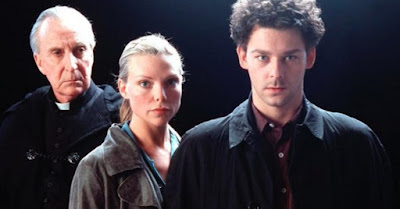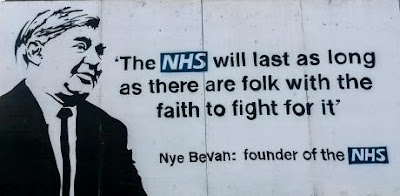Why have we memory-holed... Strange?
"IT'S a sort of supernatural whodunnit - only one of them is a demon."
That's how nurse Jude Atkins summed up the increasingly disturbing murder mystery at the heart of BBC drama Strange.
It's a synopsis she'd have done well to share with The Radio Times when the pilot episode aired a little over 20 years ago.
At a time when British TV was especially averse to sci-fi and fantasy shows, comparisons were thin on the ground and critics ran with rather lazy phrases like "the British Buffy."
In fact the show owed as much to Agatha Christie adaptations as it did a certain teen drama from the other side of the Atlantic.
Uncertainty over the show's target audience and quite how to pitch it meant that while a full series of six episodes followed, in the summer of 2003, that was in fact it for Strange. A cliffhanger ending was left, well, hanging and the programme was quickly forgotten.
Which is a damn shame as it remains one of my favourite genre shows and had it arrived a year or two later could have enjoyed the sort of success which greeted the likes of Life on Mars.
For those who didn't catch it at the time - it's never been repeated and no DVD release followed - the series told the story of sinister goings on in a rather drab cathedral city somewhere in England.
The community is unlucky enough to be a gathering place for demons and - since most can readily take human form - it's not always easy to spot them. It's not quite the Hellmouth - it's rather rainier for starters - but one can imagine the considerable body count has a similar effect on property prices.
One man set on rooting out the unwelcome guests is former priest John Strange; forced from the church in mysterious circumstances and now eking out an existence in occult research.
Strange, as played by Richard Coyle, is very much not Sunnydale's favourite vampire slayer. He's not the chosen one. He doesn't have superpowers or an arsenal of lethal weaponry. In fact when we first meet him he's not even got an electricity supply.
What he does have is a very personal reason for uncovering the Devil's agents on Earth and this personal tragedy is something that is expertly uncovered as the series unfolds.
Joining him in his search is Jude, whose interest comes from her own abrupt and very unpleasant encounter with the supernatural during the course of the aforementioned pilot.
It would have been tempting to have injected some Mulder and Scully-style sexual tension into the partnership but the show admirably swerves that. Instead we have two friends, both just out of relationships and struggling to get by.
Not just, it has to be said, with newly single status but the increasing sense that the world is, as Strange puts it, "unravelling."
At every turn their investigations are thwarted by Canon Black (a formidable Ian Richardson, pictured above). As his name would suggest he's very much not a nice man.
Swaddled in dark robes and with a voice like an ice-bath - basically Francis Urquhart in a dog collar - he spends most of the series stalking cloisters and doing his damnedest to keep the weird goings-on under wraps.
The crucial question is just why the clergyman is so committed to a cover-up. Is it simply a fear of what a public panic would mean for cathedral shop sales or is he himself in league with demonic forces?
Unfortunately Canon Black's murky motives were one of many threads left dangling by the decision to axe a planned second series.
The demons themselves - whose "monster of the week" appearances gave each episode its name - were perhaps most interesting for the way they embraced the modern world.
There was something quite unsettling about the idea that the nightmarish entities of old folktales were now operating tattoo parlours, riding night buses or tapping into the National Grid.
It's true some of the tactics were as icky as they were innovative - the idea that an ancient incubus had taken to cultivating its young within women's breast implants was perhaps a step too far - but the idea of 21st century trappings being exploited by monsters was sound.
In fact it feels like exactly the approach that Russell T Davies took when he rebooted Doctor Who a few years later.
The parallels don't end there. Richard Coyle - with his untamed hair and three quarter length coat - could plausibly pass for a lost incarnation of the Time Lord. Samantha Janus, like Billie Piper, had first come to public attention as a teenage singing star. And Strange's main director Joe Ahearne would later be entrusted with some of the best-remembered episodes of Doctor Who's debut series.
Perhaps the most tangible tip of the hat came in the final episode, when none other than Tom Baker himself enters the fray as Strange's friend and mentor Father Simeon (above) - because who else would you cast as an obviously eccentric blind monk?
Strange of course had its flaws. The third act reveal of which of that week's ensemble wasn't in fact human ran the risk of becoming formulaic.
You could almost guarantee that by ten to ten a seemingly respectable member of the community would be revealed as an agent of evil on Earth - the early noughties equivalent of the nice man at the Post Office who suddenly lets slip he thinks Suella Braverman talks a lot of sense. That, but with glowing eyes.
Our hero's habit of blundering into encounters with the forces of darkness without as much as a holy relic or anything resembling a plan also means the manner of their defeat could be decidedly mixed.
Strange's eleventh-hour escape from a world-weary banshee - one of the series' most unsettlingly adversaries - is both poignant and plausible.
But his showdown with Kaa-Jinn, a creature assembled from dismembered cadavers and judging by his pained expression none too happy about it, is rather more chaotic. In actual fact it amounts to a pretty desperate wrestling match and Strange resorting to kneeing his nemesis in the gonads.
"Welcome to the human body," he crows, as the grimace becomes even more pronounced. A good line, but perhaps not paired with a strategy to be imitated by anyone with long-term hopes of eventual retirement from the demon-hunting business.
And arguably inevitably for any genre show which probably had the same per episode budget as Casualty the special effects are what could charitably be described as low-key.
This means that the drama has to rely on setting and sound for atmosphere - no bad thing in itself - but also that whatever demon emerges from the darkness is invariably a guest actor in contact lenses.
Although to its credit the series does extend its ambition to a phantom coach, flesh-eating devilspawn and a vampiric tree beast in its second half and these are actually fairly respectable. Enough is kept in the shadows and the camera cuts away quickly enough to allow for a reveal that never feels ridiculous.
Why then did Strange never see its way to a second run?
The BBC's evident uncertainty over how best to market the series was at least part of the problem. The decision to schedule a show seemingly perfect for gusty autumn nights at the height of barbecue season - or what passes for that period in Britain - also didn't help.
Nor did failing to repeat the pilot ahead of the full series, which left those who had missed it without an obvious "jumping on" point.
Perhaps most importantly however was the fact that this was a period where sci-fi and fantasy were a hard sell for UK broadcasters. The Beeb was happy to buy in popular titles from the United States and park them in an early evening slot on BBC2, but they were rather less confident - one might even say embarrassed - about their own homegrown commissions.
It's interesting that even the revival of Doctor Who, which got the greenlight just weeks after Strange had aired, didn't properly pave the way for a post watershed offering.
Yes there was a proliferation of Saturday family shows - Merlin, Primeval and Robin Hood among them - which felt like glossier, more gung-ho takes on what would have once been prime candidates for a Sunday serial slot.
But adult sci-fi was still a rather furtive affair, often smuggled in under the cover of other genres. Life on Mars was as much sold as an old-fashioned cop show as it was a time travel piece, while BBC3's Being Human was initially marketed as a flat share comedy which only happened to star a vampire, a ghost and a werewolf.
Had Strange lent more heavily on its supernatural whodunnit formula it may have succeeded. A somewhat similar format managed to sustain Sea of Souls - a drama about supernatural investigations in Scotland - rather longer.
But that show arguably took fewer risks in order to win over those who were in truth more comfortable with plain old-fashioned murders than the idea that Old Nick and his emissaries might have infiltrated the Church of England.
The rather more mature Bill Paterson played the lead, there was less humour and, at least initially, enough ambiguity about the spooky side of things to win over those who were sceptical about ghosts in the same way that a slightly older generation of Britons also mistrust contactless card payments and jalapeno peppers.
Strange by contrast didn't compromise, it didn't retreat to the comfort zone of a more provincial setting or an older actor to win over waverers.
It definitely wasn't Buffy but it wasn't Inspector Morse either. It cast young, attractive leads and then dressed them entirely sensibly. It conjured a world where horrendous things could and did happen, but wasn't afraid to raise a smile now and then. It ruminated on real-life struggles, such as being a single parent or suffering a tragic bereavement, through the prism of a conflict with demonic forces.
Perhaps another version of this show would have lasted longer but I'm not sure it would have been better.







Comments
Post a Comment